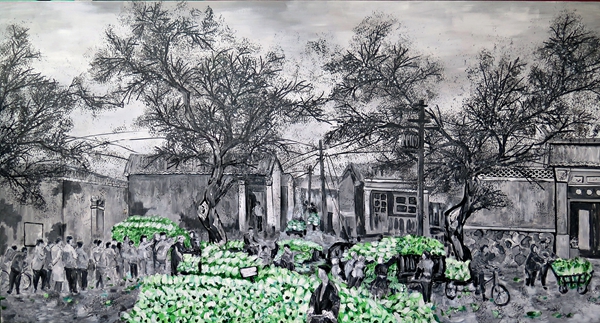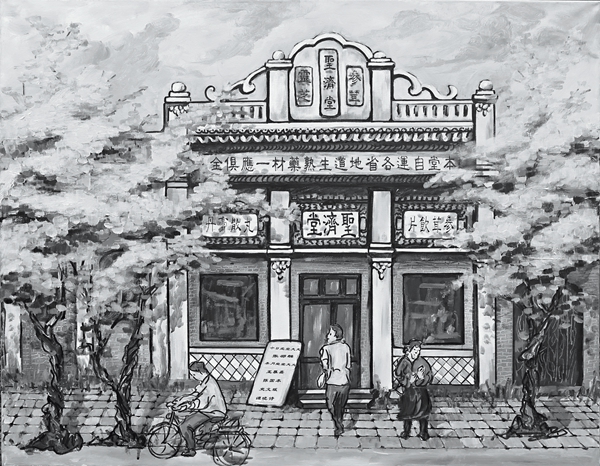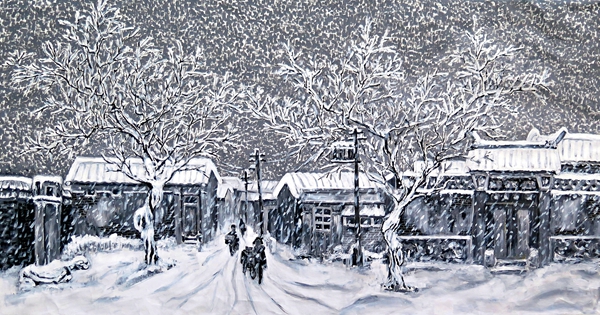Scenes from the Memory of a Native Beijinger
China Today,September 18, 2017 Adjust font size:
LIAO Zengbao, 72, was born in a hutong in Xinjiekou, Beijing’s Xicheng District. He has been witness to many of the city’s vicissitudes. For him, these transitions are not historical tableaus, but rather memories of his everyday life. An amateur painter, Liao has used his brush to recreate scenes from his life over the past few decades.

The Forbidden City in Snow.
Under the theme Beijing’s Hutong Memory, dozens of Liao Zengbao’s works went on exhibition recently in Meiliyuan Community square in Hai-dian District. Picturing such aspects of Beijing life as hutongs, temple fairs, and the Meridian Gate of the Forbidden City, each painting reflects Beijing’s historical features at a certain time.
Depictions of People’s Lives
Mrs. Liu, 80, admired Liao’s painting of Jiangyangfang Hutong. Portraying bygone scenes of the hutong (today’s Xinjiekou East Street), it brought back many memories. Liu often walked past the hutong on her way to a nearby barber’s shop. Once, after suffering a bone fracture, she cut through the hutong to Jishuitan Hospital. “Many of the shops that used to be there are long gone,” Liu said. The exhibition also includes paintings of Beijing’s temple fairs, of the Rusticated Youth Campaign, when young people were sent to work in rural and mountainous areas, outdoor cinemas in the 1960s and 70s, and storing cabbages for the winter. All are aspects of bygone daily life in Beijing’s hutongs.

The Shibei Hutong.
Among Liao’s works are a series of 18 oil paintings entitled Changes to Shibei Hutong. Originally located in Liubukou, one third of it housed the quadrangle dwellings of magnates and merchants. The remainder was occupied by warrens of workers’ family homes.
These paintings reenact people’s daily life after the founding of the People’s Republic of China. Urban development brought a mushrooming of new communities which completely changed hutong life. “When I was at high school, we would go to harvest cabbages in the bitter cold winter weather. Even the ground was frozen. But winter in Beijing is much warmer now,” Liao said.
Teahouse Enlightenment
Having been born and raised in Beijing, Liao has witnessed the city’s extraordinary development. He has particularly profound memories of the capital’s hutongs. When he retired, Liao painted to record his experiences, and what he saw and heard.

An Old Herbal Medicine Shop in Beijing.
Liao says that the influence of famous Chinese novelist and dramatist Lao She is the main reason why he uses hutong as a medium to reflect the city’s changes. “I greatly admire Lao She. His drama Teahouse is still popular and will undoubtedly endure. A standard hutong seems to me the perfect showcase for Beijing’s twists and turns,” Liao said.
Learn More about Beijing’s History
One particularly striking painting in Liao’s exhibition is the long scroll portraying a typical Beijing temple fair. With Huguo Temple Fair as the backdrop, Liao has recreated this vivid, colorful 1960s scene, featuring folk acrobatic performances, handicrafts, and traditional snacks, in all its vibrant vitality.

The Memory of a Hutong.
Liao says that snacks are the main attraction at temple fairs these days, but go beyond traditional Beijing specialties to include Western favorites like pizza. “I think the entire essence of temple fairs has changed,” Liao said. “I wish more people could know what a real temple fair was like.”
Liao intends to recreate these aspects of Beijing life for those who missed out on them. For instance, there used to be a huge vat of water in each household, replenished by the many water wagons rolling through Beijing. This feature of everyday city life is not dissimilar from that of today, with large bottles of water delivered by tricycle. In earlier times, it was customary to keep a small crucian carp in the vat. Its health was an indicator of the water’s quality.

“I hope through this exhibition people could see the contrast between Beijing’s past and present,” Liao said.
Hutongs are a unique view of Beijing and carriers of its history and culture. Liao’s exhibition also includes supplementary information about hutongs, including photos of how they look now, if indeed they remain, to amplify its visual impact. “If the exhibition acquaints people with Beijing’s history and how life progressed from liberation to the present day, then I ask for no more,” Liao said.